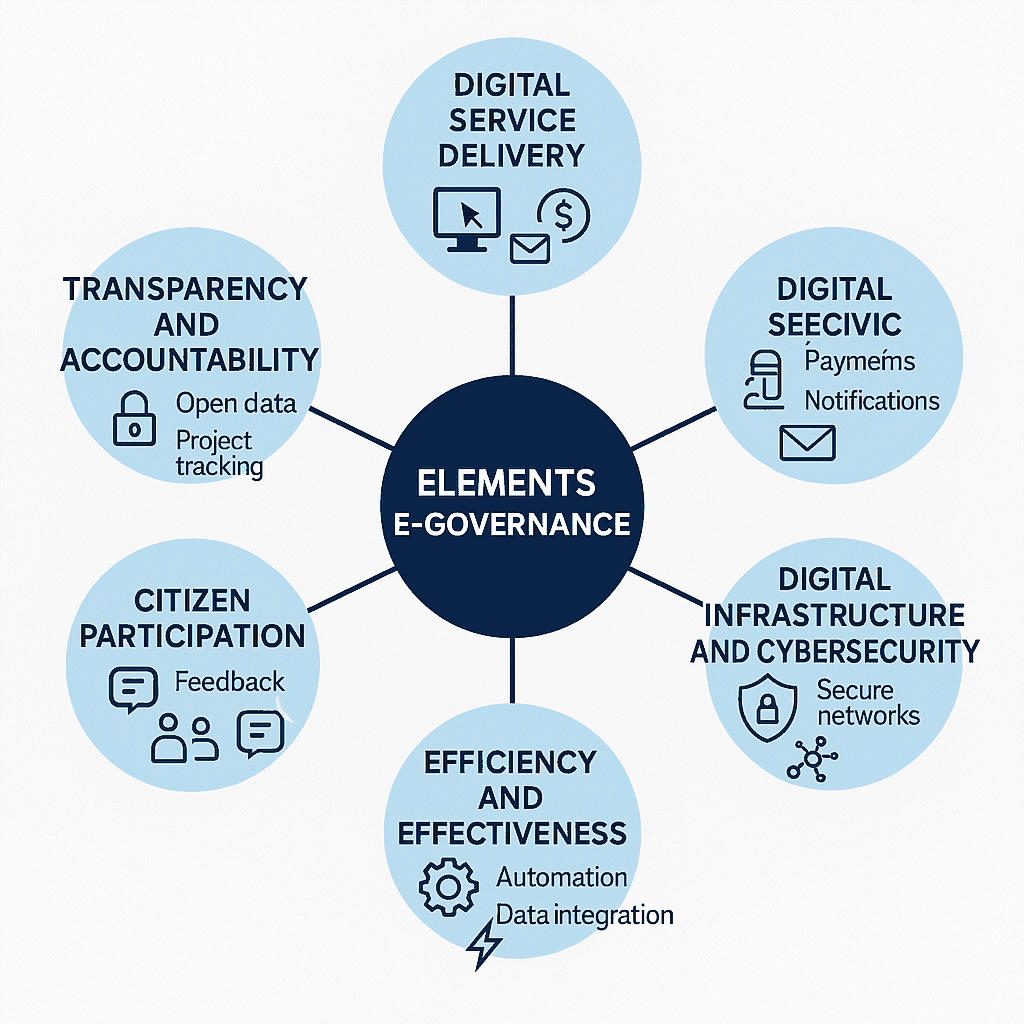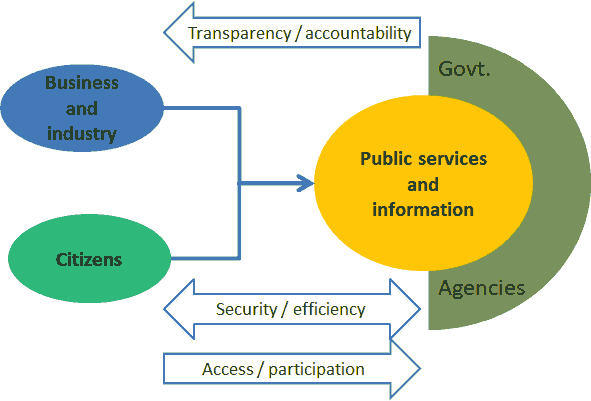
Urban E-Governance
Defining E-Governance
Hari Srinivas Explainer Series C-081
In an increasingly digital world, governments are leveraging technology to enhance governance, improve public service delivery, and foster citizen participation. E-Governance is the strategic use of Information and Communication Technologies (ICTs) to create a more efficient, transparent, and accountable government system. It bridges the gap between governments and citizens, streamlining processes, reducing bureaucratic inefficiencies, and promoting greater public engagement.
More than just a technological shift, e-governance represents a transformation in how governments operate, interact with stakeholders, and ensure inclusive decision-making. The following sections explore the various dimensions of e-governance, highlighting its scope, functions, and impact.
Elements of e-governance
Figure 1: Elements of e-governance
- Digital service delivery: E-governance aims to provide citizens and businesses with convenient and accessible digital channels to access government services and information. This can include online portals for obtaining licenses, paying taxes, applying for permits, accessing public records, or receiving notifications.
- Transparency and accountability: E-governance promotes transparency by making government information and processes accessible to the public through digital platforms. It allows citizens to access public data, monitor government activities, track the progress of projects, and hold government officials accountable for their actions.
- Citizen participation: E-governance encourages citizen engagement and participation in the decision-making processes of governance. It provides mechanisms for citizens to provide feedback, participate in online consultations, contribute to policy discussions, and collaborate with government agencies in problem-solving and service improvement.
- Efficiency and effectiveness: By digitizing administrative processes, e-governance aims to streamline government operations, reduce bureaucracy, and enhance the efficiency and effectiveness of public service delivery. It enables automation, data integration, and online transactions, which can lead to cost savings, improved resource allocation, and faster response times.
- Digital infrastructure and cybersecurity: E-governance requires robust digital infrastructure, including secure networks, data centers, and information systems, to ensure the reliability, privacy, and security of digital services and transactions. It involves implementing cybersecurity measures to protect government systems and citizens' data from unauthorized access, cyber threats, and information breaches.
Box: Elements of e-governance
Figure 2: Benefits of e-governanceAs illustrated in Figure 2, e-governance frameworks target three stakeholders - government agencies on one hand, and business/industry and citizens on the other. While businesses and citizens can have easier access to government services and information, and better participate in public policy making, government agencies can provide public services in a transparent and accountable manner - increasing overall efficiency and effectiveness.
The key aspects of e-governance can be categorized into the following sub-themes:
Definition and Scope of E-Governance
E-Governance represents a paradigm shift in how governments interact with citizens, businesses, and other institutions. It leverages digital tools to enhance public administration and participatory governance. Clarifying its scope helps distinguish it from traditional governance and e-government.
- E-Governance involves the application of ICTs to government services, facilitating interactions between Government-to-Citizens (G2C), Government-to-Business (G2B), and Government-to-Government (G2G).
- It is a digital model of governance that enhances service delivery, communication, and information exchange within and beyond the public sector.
- E-Governance differs from e-government by emphasizing not only service delivery but also democratic participation and decision-making processes.
Core Functions and Objectives
The core purpose of e-governance lies in transforming governance processes to be more streamlined, transparent, and inclusive. These objectives reflect a broader shift toward accountable and citizen-oriented public service. Digital tools play a critical role in achieving these functions effectively.
- The primary goal of e-governance is to improve government efficiency, effectiveness, and transparency through digital means.
- It simplifies administrative processes, making governance more accessible to citizens, businesses, and other stakeholders.
- The adoption of ICTs enables a more accountable and participatory governance model, fostering trust between governments and the public.
Digital Governance and Service Delivery
Digital service delivery is at the heart of e-governance, allowing governments to provide faster, more accessible, and user-friendly services. This dimension emphasizes the role of ICTs in removing administrative bottlenecks. It represents a tangible improvement in how citizens experience government.
- E-Governance facilitates seamless digital transactions, enabling online access to public services such as tax payments, business registrations, and government forms.
- Centralized digital platforms provide citizens with easy access to government resources and information.
- ICTs enhance public administration by streamlining workflows, automating processes, and reducing bureaucratic inefficiencies.
Citizen Engagement and Digital Democracy
E-governance supports deeper citizen engagement by opening up new digital channels for public input and feedback. This strengthens democracy by making it easier for citizens to participate in governance. It also fosters transparency and inclusiveness in decision-making.
- E-Governance fosters citizen participation in governance through digital platforms, enabling public discussions, consultations, and policy feedback mechanisms.
- It empowers citizens to engage in decision-making processes, ensuring that governance is more inclusive and representative.
- Digital democracy initiatives promote transparency by providing citizens access to government data and policy-making processes.
Multi-Stakeholder Involvement
Effective e-governance requires collaboration beyond the public sector. Involving businesses, civil society, and academic institutions enriches policy outcomes and service design. Multi-stakeholder participation ensures broader ownership and innovation in digital governance.
- E-Governance operates as a network involving governments, civil society organizations, businesses, and private-sector entities.
- It facilitates collaboration among stakeholders by creating digital platforms for coordination, policy discussions, and service integration.
- Nonprofits, academic institutions, and businesses play a role in shaping digital governance policies and solutions.
Good Governance and Ethical Considerations
Ethics and inclusivity must be embedded in all e-governance initiatives. Protecting privacy, ensuring access, and promoting transparency are vital for trust. Good governance principles are amplified through responsible digital practices.
- E-Governance enhances governance through principles such as accountability, transparency, responsiveness, and inclusivity.
- The concept of SMART governance (Simple, Moral, Accountable, Responsive, Transparent) highlights the ethical and operational standards that e-governance should uphold.
- Governments must ensure digital security, privacy protection, and accessibility for all, including marginalized communities.
Technological Foundations and Innovations
Rapid technological advances are reshaping how governments design and implement digital systems. E-governance must adapt continuously to integrate these innovations effectively. The choice of technologies influences both the scale and equity of service delivery.
- Emerging digital technologies, including cloud computing, blockchain, artificial intelligence, and mobile connectivity, are transforming e-governance frameworks.
- The integration of ICTs ensures the automation of government services, reducing redundancy and improving efficiency.
- E-Governance leverages the internet and mobile networks to extend public services beyond physical government offices.
E-Governance as a Global and National Strategy
E-governance has emerged as a strategic tool in both national policy agendas and international development goals. It enables better public sector performance and greater alignment with global governance norms. Countries tailor their approaches based on capacity, context, and institutional needs.
- Governments worldwide implement e-governance strategies to improve policy execution, economic management, and public service delivery.
- National and local governments adopt digital governance models based on their specific needs, legal frameworks, and technological capacities.
- International organizations, such as the UN and UNESCO, advocate for e-governance as a means to enhance good governance globally.
E-Governance is not just about digitizing government services; it is a fundamental shift in how governments interact with citizens, businesses, and institutions. By leveraging ICTs, e-governance promotes transparency, strengthens democratic participation, and enhances service delivery.
However, its success depends on inclusive access to digital platforms, robust cybersecurity measures, and a commitment to ethical governance principles. As technology continues to evolve, e-governance will remain at the forefront of shaping responsive, accountable, and citizen-centric governance systems worldwide. The future of governance lies in embracing digital transformation to build more resilient and participatory societies.
|
|
 |
Return to E-Governance Contact: |


